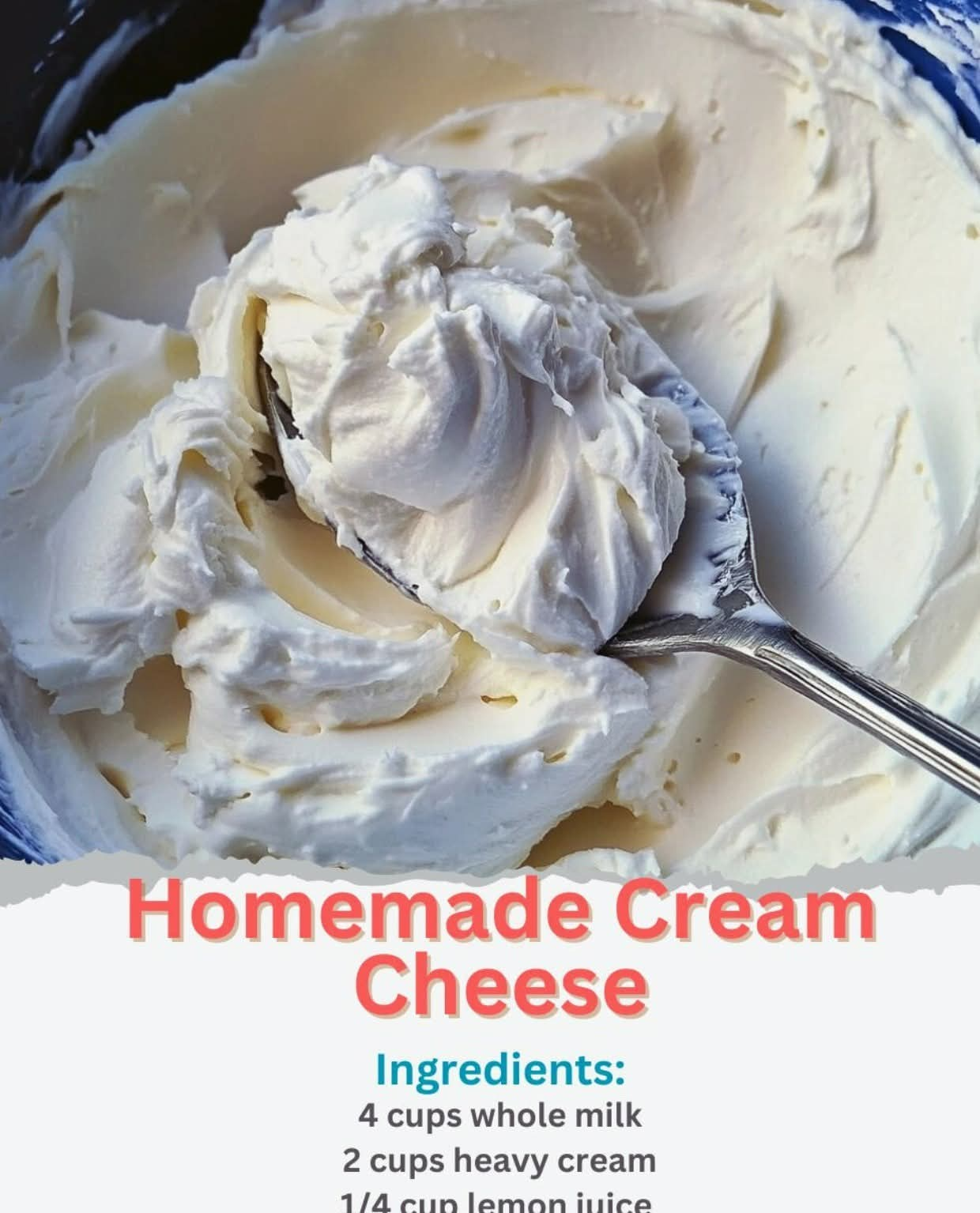Absolutely! Here’s a long, detailed, and rich recipe for Homemade Cream Cheese, including its history, formation process, methods, and even a nod to the people who love it. Let’s dive deep into the creamy, dreamy world of homemade cream cheese.
🧀 Homemade Cream Cheese: A Creamy Classic from Scratch
Introduction
Cream cheese is a soft, mild-tasting fresh cheese that has become a beloved staple across kitchens and cuisines. From the creamy schmear on a bagel to the rich base of a classic cheesecake, this cheese holds an important place in the hearts of home cooks and professional chefs alike.
While store-bought cream cheese is convenient, homemade cream cheese offers a deeper flavor, smoother texture, and the satisfaction of crafting something delicious entirely from scratch. Whether you’re a seasoned cook or an adventurous beginner, this homemade version is easy to make and endlessly customizable.
🧾 Ingredients (Yields approximately 2 cups of cream cheese)
- 4 cups whole milk (fresh, non-UHT is best)
- 2 cups heavy cream (for richness and smooth texture)
- ¼ cup lemon juice (or white vinegar) – used to curdle the milk
- ½ teaspoon salt (optional) – enhances flavor
- Optional Add-ins for Flavor Variations:
- Fresh herbs (chives, dill)
- Garlic
- Cracked pepper
- Honey or fruit for a sweet twist
🥄 Instructions & Method
Step 1: Heat the Milk & Cream
In a heavy-bottomed saucepan, pour in the whole milk and heavy cream. Place the pan over medium heat and slowly warm the mixture until it reaches about 185°F (85°C). Stir occasionally to prevent scorching.
Tip: A thermometer helps with precision, but if you don’t have one, heat until it just begins to simmer with small bubbles forming at the edges—do not boil.
Step 2: Curdle the Mixture
Once heated, turn off the heat. Slowly stir in the lemon juice or vinegar, one tablespoon at a time. Gently stir for 30 seconds and then let the mixture sit undisturbed for 10-15 minutes.
You will see curds (solid white chunks) separating from the whey (a clear yellowish liquid). This is the magical transformation where milk begins its journey to becoming cheese.
Step 3: Strain the Curds
Place a cheesecloth (or a clean thin kitchen towel) over a large bowl or colander. Carefully pour the curdled mixture into the cloth, allowing the whey to drain out.
Let it drain for 1–2 hours, depending on how thick you want your cream cheese. The longer it drains, the firmer it becomes.
Step 4: Blend Until Creamy
Once drained, transfer the curds into a food processor or blender. Add salt (if using) and blend until smooth and creamy. This step transforms the rough curds into a luscious, silky cheese.
If the cheese is too thick, add a teaspoon of whey (the liquid you drained) at a time until you reach the desired consistency.
Step 5: Store or Customize
You can enjoy it plain or add flavorings at this stage—herbs, roasted garlic, smoked paprika, or even honey and strawberries for a sweet spread.
Transfer to an airtight container and refrigerate. Homemade cream cheese keeps well for up to 7 days in the fridge.
🧬 The Science & Formation of Cream Cheese
Cream cheese is a fresh, unaged cheese made by acidifying milk and cream, then draining off the whey to leave behind a soft curd. The acid (lemon juice or vinegar) causes casein proteins in the milk to coagulate, forming curds.
Unlike aged cheeses like cheddar or gouda, cream cheese doesn’t require rennet, mold cultures, or months of ripening. It’s ready in hours, not months—making it ideal for home kitchens.
The final product is emulsified to achieve its smooth consistency. Adding cream and blending gives it that unmistakable silky texture.
🕰️ A Brief History of Cream Cheese
Cream cheese traces its roots back to Europe, where soft, unripened cheeses were commonly made. However, modern cream cheese as we know it was developed in the United States in the late 19th century.
In 1872, a dairyman named William Lawrence in Chester, New York, accidentally created cream cheese while trying to reproduce a French cheese called Neufchâtel. He began mass-producing and distributing it under the Philadelphia brand, a name chosen to associate the product with the high-quality dairy reputation of the region.
From humble beginnings, cream cheese grew into a household staple, celebrated in recipes from classic New York-style cheesecake to savory dips, bagel spreads, and frostings.
💕 Cream Cheese Lovers Unite
People adore cream cheese for its versatility and velvety richness. It holds a special place in brunches and breakfasts—especially for bagel lovers. Cheesecake aficionados depend on its structure and flavor. Bakers turn to it for ultra-moist cakes and smooth frostings.
Whether you’re making:
- A classic cheesecake
- Whipped cream cheese frosting
- A savory herb dip
- Or just spreading it on a toasted bagel
Homemade cream cheese is a game-changer.
🧑🍳 Why You’ll Love This Recipe
- Minimal Ingredients: Just 3–4 pantry staples.
- Quick & Easy: Done in under 3 hours, mostly hands-off.
- Customizable: Sweet or savory, you decide.
- Creamier & Fresher than anything you’ll find in stores.
🏁 Conclusion: The Joy of Homemade
Homemade cream cheese is more than a recipe—it’s a return to the roots of cooking. It invites us to slow down, connect with our food, and taste the difference of fresh ingredients crafted with care.
So next time you reach for that store-bought tub, pause—and consider crafting your own. Once you do, you’ll never look at cream cheese the same way again.
If you’d like a printable version or want variations (e.g., low-fat, vegan, or flavored), let me know—I’d be happy to help!
